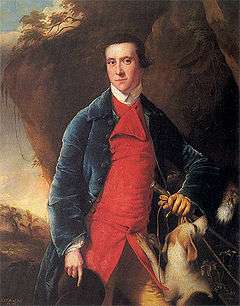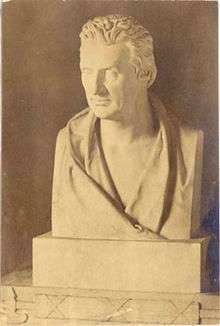Francis Noel Clarke Mundy
Francis Noel Clarke Mundy (1739 – 1815) was an English poet. His most noted work was written to defend Needwood Forest which was enclosed at the beginning of the 19th century. He was the father of Francis Mundy.
Francis Noel Clarke Mundy | |
|---|---|
 c. 1762, by Joseph Wright of Derby | |
| Born | 15 August 1739 |
| Died | 23 October 1815 |
| Resting place | Allestree Church |
| Nationality | English |
| Education | Repton, Winchester and New College, Oxford |
| Occupation | magistrate, landowner and poet |
| Known for | Poetry |
| Successor | Francis Mundy |
| Spouse(s) | Elizabeth Elizabeth Burdett |
| Children | Francis Mundy and Charles Godfrey Mundy |
| Parent(s) | Wrightson Mundy and Anne (was Burdett) |
Life
Francis Noel Clarke Mundy was born 15 August 1739 at Osbaston Hall, Osbaston, Leicestershire, which at that time belonged to the Mundys a family which had been based in Markeaton since John Mundy bought lands in Derbyshire. He received his education at Repton School and at Winchester and then proceeded to New College, Oxford in 1757,receiving his MA in 1761.[1][2]
In 1762–3, Joseph Wright exhibited a set of six portraits that were commissioned by Mundy. Each of the portraits were in the distinctive dress of the Markearton Hunt consisting of yellow breeches and a blue coat over a scarlet waistcoat. These paintings hung at the ancestral home of Markeaton Hall.[3] The subjects of these commissions included old school friends like Harry Peckham K.C. and relatives like his brother-in-law, Francis Burdett.
Mundy married first Elizabeth Ayrton who died in Falmouth aged 22 on 1 October 1768. He then married Elizabeth eldest daughter of Sir Robert Burdett bart in 1770 and had two sons: Francis and Charles Godfrey[notes 1] His second wife died in 1807 aged 64.[1] As a poet he is considered part of the Lichfield circle.[2]

_-_Google_Art_Project.jpg)
Mundy died in 1815 and the magistrates of Derbyshire commissioned a bust by Francis Chantrey which was placed in the county hall in memory of his long and eminent services as justice of the peace and chairman of the quarter sessions.[4] The bust bears the following inscription:
"This Effigy is consecrated by his Countrymen to the Memory of Francis Noel Clarke Mundy who having modestly declined their unanimous Offer to elect him their Representative in Parliament continued to preside on the Bench of Justices in this Hall during a period of nearly 50 years with a clearness of judgment and an integrity of decision well worthy of being gratefully and honourably recorded This excellent Man admired for the elegance of his literary Productions beloved for the gentleness of his Manners revered for his public and private Virtues lived happily at his paternal seat at Markeaton to the age of 76 years May his Example excite Emulation "[1]
In addition there is an engraving of him with his grandson, William Mundy, by Charles Turner (after R. R. Reinagle). The picture also features in the foreground the manuscript of Mundy's ‘'The Fall of Needwood Forest’'. South Derbyshire magistrates court also own an oil painting of him "after" Thomas Lawrence.[5]
Work
Mundy was the author of two admired descriptive poems Needwood Forest (1776)[6] and the Fall of Needwood (1808).[7] Needwood Forest was a large ancient woodland in Staffordshire which was destroyed under the authority of the Inclosure Act of 1803. Despite Mundy's and other protests it was removed by 1811. Anna Seward regarded his poem, Needwood Forest, as "one of the most beautiful local poems" and "the first entirely local poem in our language"[8] and persistedly promoted Mundy's poetry, writing verses in praise of it.[9] However she also claimed that large portions of Needwood Forest were actually written by herself and by Erasmus Darwin.[10]
Needwood Forest was well regarded in its time, and is an example of the provincial verse that was starting to become a feature of late eighteenth century English literature. The poem, which is in five parts is written in octosyllabic couplets and contains allusions to Milton, Spenser, Denham and Pope.[11] It was printed privately (500 copies as presents to his friends) and is appended with a number of commendatory verses, by fellow Lichfield poets Sir Brooke Boothby, Erasmus Darwin and Anna Seward (attributed only by their initials). Seward tried to persuade Mundy to publish the poem publicly.[11] The Fall of Needwood also contains three shorter poems, see below (p. 37). There also existed an edition combining the two earlier volumes, with different pagination to the original volumes.[12][13] The appended poems also differ. Following the grand climacteric there are two commendatory poems, by Seward and by Hayley.
In the posthumous 1830 edition are appended the 1808 poems and five others, titled Miscellaneous Pieces (p. 97). One of these, The Backwardness of the Present Spring Accounted For, May 5th, 1782 (p. 110), has also been attributed to Anna Seward.[14]
Selected poems and publications
Poems include;[2]
- 1758 Winter
- 1765 Ode to Health
- 1765 The Harehunter
- 1768 Poems
- 1776 Needwood Forest
- 1808 Fall of Needwood
- Learning to spin n.d.
- On a picture by R.R. Reinagle n.d.
- 1802 My grand climacteric
- 1809 To my grandson William
- 1830 Needwood forest, and The fall of Needwood: with other poems
- The Backwardness of the Present Spring Accounted For, May 5th, 1782
- Miss Bettina Webster
- On reading verses by the Hon. Julia Curzon
- The Papplewick coursing
- To the Hon. Lady Cavendish
Legacy
In 1830, two volumes were published which made available the many poems not published during Mundy's lifetime.[1][15] Finally, in 1851, William Mundy paid for a memorial window to his grandfather to be installed in Markeaton church.
Notes
- Of Burton Hall near Loughborough in the county of Leicester
References
- Bigsby 1854, Francis Noel Clarke Mundy p. 276–282.
- Radcliffe 2015, Francis Noel Clarke Mundy (1739–1815).
- Sotheby's 2005.
- Burke 1835, Francis Noel Clarke Mundy p. 26.
- BBC 2015.
- Mundy 1776.
- Mundy 1808.
- deLucia 2013.
- Bowerbank 2004, Anna Seward as environmental writer p. 177.
- Barnard 2013, 'A free agent' p. 110.
- Radcliffe 2015, Needwood Forest 1776.
- Parkin 1875.
- Mundy 1776a.
- George 2005.
- Mundy 1830.
Bibliography
- Bigsby, Robert (1854). Historical and topographical description of Repton, in the county of Derby. London: Woodfall & Kinder.CS1 maint: ref=harv (link)
- Burke, John (1835). A Genealogical and Heraldic History of the Commoners of Great Britain and Ireland, Enjoying Territorial Possessions Or High Official Rank: But Uninvested with Heritable Honours, Volume 1. London: Henry Colburn.CS1 maint: ref=harv (link)
- "Francis Noel Clarke Mundy, Esq. (1739–1815)". Art UK. 2015.
- "Joseph Wright of Derby, A.R.A. 1734-1797. Portrait of Launcelot Rolleston (1737-1802), of Watnall Hall (Markeaton Hunt Portraits)". Important British Paintings 1500-1850. Sotheby's. 30 June 2005.
- Radcliffe, David Hill (2015). "Welcome". English Poetry 1579-1830: Spenser and the tradition. Virginia Tech.CS1 maint: ref=harv (link)
- Parkin, John (1875). "F.N.C.Mundy". Notes and Queries. Fifth Series Vol. 4 August 7 (84): 110.CS1 maint: ref=harv (link)
- Gottlieb, Evan; Shields, Juliet, eds. (2013). Representing place in British literature and culture, 1660-1830 : from local to global. Farnham. ISBN 9781409419303.CS1 maint: ref=harv (link)
- DeLucia, JoEllen. Mundy’s Needwood Forest and Anna Seward’s Lichfield Poems. pp. 155–172. in Gottlieb & Shields (2013)
Mundy and Seward
- Barnard, Teresa (2013). Anna Seward: A Constructed Life: A Critical Biography. Farnham: Ashgate. ISBN 9781409475330.CS1 maint: ref=harv (link)
- Grundy, Isobel (4 February 2010). "Anna Seward: A Constructed Life, A Critical Biography". Times Higher Education Book Reviews.CS1 maint: ref=harv (link)
- Bowerbank, Sylvia (2004). Speaking for nature : women and ecologies of early modern England. Baltimore: Johns Hopkins University Press. ISBN 9780801878725.CS1 maint: ref=harv (link)
- George, Sam (June 2005). "'Not Strictly Proper for a Female Pen': Eighteenth-Century Poetry and the Sexuality of Botany". Comparative Critical Studies. 2 (2): 191–210. doi:10.3366/ccs.2005.2.2.191.CS1 maint: ref=harv (link)
Works by Mundy
- Mundy, Francis Noel Clarke (1776). Needwood Forest. Lichfield: Jackson.CS1 maint: ref=harv (link) (reprinted by Drewery, Derby 1811)
- Mundy, Francis Noel Clarke (1808). The Fall of Needwood. Derby: Drewry.CS1 maint: ref=harv (link)
- Mundy, Francis Noel Clarke (1830). Needwood forest, and The fall of Needwood: with other poems. Derby: Richardson.CS1 maint: ref=harv (link)
- "Francis Noel Clarke Mundy Poems (9 poems)". Inspirational poems, poetry, quotes. 2015.
- Mundy, Francis Noel Clarke (1776a). Needwood Forest (dual edition with The Fall of Needwood).CS1 maint: ref=harv (link)
| Wikimedia Commons has media related to Francis Noel Clarke Mundy. |